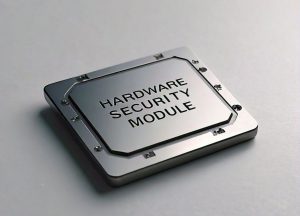In today’s digital age, securing sensitive data cannot be overstated. From financial institutions to government agencies, protecting information from unauthorised access is crucial. One of the most robust tools in the arsenal of cybersecurity is the Hardware Security Module (HSM). But what exactly is an HSM, and how does it safeguard critical data? Moreover, how does it differ from Key Management Services (KMS), a commonly associated term?

Understanding Hardware Security Modules
A Hardware Security Module (HSM) is a physical device designed to manage digital keys and perform cryptographic operations. These modules are essential in securing sensitive data by providing a tamper-resistant environment for cryptographic processing. Unlike software-based solutions, HSMs offer higher security by physically protecting the keys and operations within a dedicated piece of hardware.
Key Functions of an HSM
- Key Generation and Storage:
HSMs generate cryptographic keys using a true random number generator (TRNG) and store them securely within the module. These keys are never exposed outside the HSM, ensuring that they cannot be extracted or tampered with.
- Encryption and Decryption:
HSMs perform encryption and decryption operations within the secure environment of the module. This ensures that sensitive data is protected during these processes, reducing the risk of exposure to malicious actors.
- Digital Signatures:
By generating and verifying digital signatures, HSMs ensure the authenticity and integrity of electronic documents and transactions. This is crucial in applications such as secure communications, financial transactions, and identity verification.
- Certificate Management:
HSMs play a vital role in Public Key Infrastructure (PKI) by managing digital certificates. They ensure that certificates are securely issued, stored, and revoked, maintaining the trustworthiness of the PKI.
Differentiating HSM and KMS
While HSMs and Key Management Services (KMS) both deal with cryptographic keys, they serve different purposes and are often confused. Here’s how they differ:
- Purpose and Functionality:
– HSM: Primarily a physical device that provides secure key storage and performs cryptographic operations. It offers a high level of security by protecting keys in a tamper-resistant environment.
– KMS: Can be a software-based service that manages cryptographic keys throughout their lifecycle. This includes key generation, distribution, rotation, and deletion. KMS often utilizes HSMs as part of its underlying infrastructure to enhance security.
- Deployment:
– HSM: Deployed as a hardware appliance, either on-premises or in a cloud environment. It requires physical security measures and maintenance.
– KMS: Can be deployed as a hardware or virtual appliance, in some cases, it can be offered as software as well. It abstracts the complexities of key management and often integrates with various cloud services.
- Use Cases:
– HSM: Ideal for applications requiring the highest level of security, such as financial transactions, secure communications, and critical infrastructure protection. Providing enhanced protection of Root of Trust to a critical system.
– KMS: Suitable for environments where key management needs to be scalable and integrated with other cloud services, such as managing keys for encrypted cloud storage, databases, and applications.
Applications of HSMs
Here are some of the common applications of HSMs.
- Financial Services:
In the financial industry, HSMs are used to secure transactions, protect customer data, and comply with stringent regulatory requirements. They are critical in securing ATMs, online banking systems, and payment processing.
- Government and Defence:
Government agencies and defence organizations rely on HSMs to protect classified information, secure communications, and ensure the integrity of electronic voting systems.
- Healthcare:
HSMs help safeguard patient records, ensure the privacy of sensitive medical information, and comply with health data protection regulations like HIPAA.
- Telecommunications:
Telecom companies use HSMs to secure network infrastructure, protect customer data, and ensure the confidentiality of communications.
- Cloud Services:
With the rise of cloud computing, HSMs are increasingly deployed to secure cloud-based applications and data. Cloud service providers use HSMs to offer key management services and enhance the security of their platforms.
Benefits of Using HSMs
– Enhanced Security: HSMs provide a higher level of security compared to software-based solutions by physically protecting cryptographic keys and operations.
– Regulatory Compliance: HSMs help organisations comply with various regulatory standards such as PCI-DSS, GDPR, and FIPS 140-2 by ensuring secure key management and cryptographic operations.
– Performance: HSMs are optimized for cryptographic processing, providing faster and more efficient operations compared to general-purpose hardware.
– Reliability: Designed for high availability and redundancy, HSMs ensure that critical cryptographic operations are always available.
Conclusion
In an era where data breaches and cyber threats are becoming increasingly advanced, Hardware Security Modules provide a critical layer of security. By offering a tamper-resistant environment for key management and cryptographic operations, HSMs play a vital role in protecting sensitive data across various industries. Understanding the distinction between HSMs and KMS is crucial for implementing the right security solutions. As technology continues to evolve, the adoption and implementation of HSMs will remain a cornerstone of effective cybersecurity strategies.
To find out more about implementing HSM in your organisation, contact us at https://www.netrust.net/contact-us/ now.
Follow us on LinkedIn for the latest happenings/updates.


